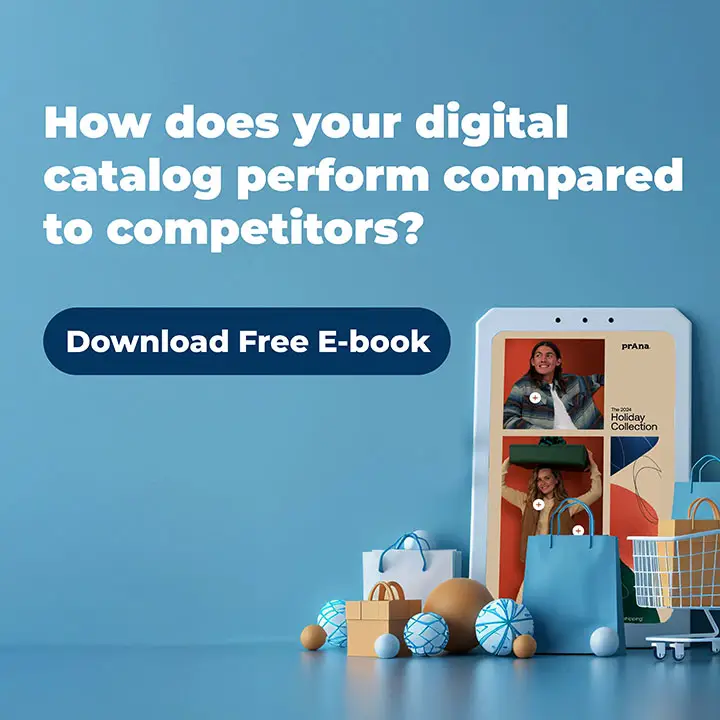Our industry benchmarks report has returned with fresh catalog performance insights for H1 2025. Our last edition, Beating the Benchmarks 2024, laid the foundation for businesses to understand how their digital catalogs and flyers performed within their industry.
How does your digital publication compare in H1? This updated benchmark report for the first half of 2025 helps businesses determine where they stand and where there’s room to grow. Industry benchmarks are essential for evaluating the effectiveness of your digital content strategy and your catalog performance. They offer a baseline to help you gauge whether your performance is above average, falling behind, or right on target
By tracking key engagement metrics like read percentage, average time spent, bounce rate, and mobile share, you can identify strengths, uncover gaps, and plan smarter content and UX optimizations tailored to your audience.
H1 2025 Catalog Performance Benchmarks by Industry
Data from January 1st to June 30th, 2025
| Industry | Avg. Pages | Read % | Time per Pub (min) | Time per Page (sec) | Bounce Rate | Mobile Share |
| Beauty | 24.65 | 54% | 2.7 | 12.2 | 29% | 93% |
| Consumer Goods | 62.21 | 58% | 5.45 | 9.15 | 23% | 81% |
| DIY/Equipment | 49.12 | 31% | 3.5 | 13.65 | 41% | 66% |
| Electronics | 15.38 | 83% | 2.75 | 12.8 | 30% | 57% |
| Fashion / Apparel | 42.84 | 53% | 4.0 | 10.6 | 21% | 67% |
| Food & Beverages | 26.33 | 88% | 3.85 | 9.9 | 26% | 80% |
| Home & Living | 48.96 | 31% | 3.2 | 12.6 | 38% | 74% |
| Manufacturing & Dist. | 44.88 | 26% | 4.8 | 24.85 | 59% | 80% |
| Sports & Outdoor | 62.38 | 53% | 5.75 | 10.45 | 36% | 51% |
| Wholesale | 44.97 | 68% | 5.5 | 10.8 | 20% | 55% |
| Average (All Industries) | 34.16 | 69% | 3.9 | 10.1 | 28% | 78% |
METRIC LEGEND
Avg. Pages: average # of single pages in a publication.
Read %: average pages viewed per visit over the average # of pages per publication.
Time per Pub (min): average time a publication is viewed per visit in minutes.
Time per Page (sec): average time a page is viewed per visit in seconds.
Bounce rate: percentage of publication opens with no additional interactions.
Mobile share: percentage of opens on mobile; the rest will (mostly) be on desktop devices.
What You Can Learn From These Benchmarks
Here are a few ways to use this data to improve your catalog performance:
- Low read %? This may mean your catalogs are too long, not engaging enough, or not aligned with what users are looking for. Try segmenting content, ensuring it’s mobile-optimized, and featuring in-stock or seasonal products upfront.
- Engagement time insights: If your engagement per publication is low but per page is high, consider shortening the publication or optimizing page flow. If both are low, it might be time to rethink your creative approach.
- Mobile matters: Mobile share is consistently high across industries. Are your catalogs designed for small screens? Use font types that are easy to read, avoid cramped layouts, and test touch interactions.
- Bounce rates can reveal friction. High bounce rates may point to slow load times, poor first impressions, or a mismatch between your audience and content focus.
Top Catalog Performance Trends From H1 2025
Beyond the individual benchmarks, a few bigger patterns have emerged across industries. From shifting mobile behavior to surprising engagement peaks, these trends offer a valuable snapshot of how digital catalog usage is evolving. Here are some key takeaways from the data from the year’s first half.
1. Food & Beverage and Electronics Lead in Engagement
Food & Beverage catalog performance was strong, achieving the highest read percentage (88%), while Electronics followed with an impressive 83%. Interestingly, both industries kept publication lengths short, around 15–26 pages. This suggests that brevity combined with relevance continues to drive engagement.
2. Mobile Remains Dominant, But Varies Widely
The average mobile share was 78%, which varied drastically by industry. Beauty topped out at 93%, confirming the importance of mobile-first design in visually-driven categories. In contrast, industries like Electronics (57%) and Wholesale (55%) had lower mobile shares, indicating continued desktop use, possibly due to business buyers or larger product specs.
Actionable tip: Know your mobile share. If it’s above 70%, designing specifically for mobile behavior; large fonts, tappable elements, and vertical layouts can be beneficial.
3. Manufacturing Has the Highest Page Engagement
Manufacturing & Distributing recorded 24.85 seconds per page, nearly 2.5x the cross-industry average. While their bounce rate was high (59%), the users who do engage spend serious time per page. This likely reflects technical or spec-heavy content that requires deeper reading. Niche industries may benefit from fewer, highly detailed publications.
Deep Diving Into Each Industry’s Key Callouts
Each industry tells a different story when it comes to how shoppers engage with digital catalogs. Some audiences browse quickly on mobile, others dive deep into technical specs on desktop. In this section, we’ve pulled out the standout metrics for each sector and a quick takeaway to help you interpret what the numbers might mean for your strategy.
Beauty
93% of opens come from mobile. Your audience is scrolling through your catalog like it’s Instagram. They’re on the go and expect rich visuals, tap-friendly layouts, and instant gratification.
Takeaway: Make it pretty. Make it engaging.
Consumer Goods
A massive 62-page average, but still 5.45 minutes of engagement. Your readers are committed. They’re browsing deeply, possibly planning a shop or comparing options.
Takeaway: Lean into intent. Guide them with curated sections or “top picks” so they don’t get lost in the scroll.
DIY / Equipment
13.65 seconds per page, but only 31% read rate. They’re digging in, but not for long. These are task-driven users, probably looking for one solution or product.
Takeaway: Add clear navigation and search-friendly layouts. Feature top tools or seasonal projects front and center.
Electronics
High read rate (83%) and solid time per page (12.8 sec), but only 57% mobile share. This is a research-heavy, desktop-leaning crowd. They want details, specs, and possibly a bigger screen.
Takeaway: Prioritize clarity over aesthetic; spec tables, reviews, and quick compare tools go a long way.
Fashion / Apparel
Low time per page (10.6 sec), but long-form scrolls (42+ pages).
They’re scanning, not studying, just like window shopping. Visuals matter more than text.
Takeaway: Hero shots, vertical scroll, and mobile styling are your power trio. Make every page a “stop the scroll” moment. Adding videos is a good way to increase engagement.
Food & Beverages
88% read rate – the highest of all.
These catalogs are snackable and satisfying. Whether it’s weekly deals or fresh recipes, this audience sticks around.
Takeaway: Keep it timely. Weekly updates, promotional banners, and recipe cross-links could boost conversions.
Home & Living
Above-average page depth (49 pages), but only 31% read rate.
Beautiful content, but possibly overwhelming. Shoppers are interested, but not finishing.
Takeaway: Add structure. Split publications by room, style, or trend. Help users find what they want fast.
Manufacturing & Distributing
Nearly 25 seconds per page, but only 26% read rate and 59% bounce rate.
This niche audience reads thoroughly when they engage, but most don’t.
Takeaway: Your content needs segmentation by product line, industry, or user type; otherwise, it can become too one-size-fits-all.
Sports & Outdoor
Solid engagement (5.75 min) but only 51% mobile share.
A balanced shopper, possibly browsing on desktop at work and mobile on weekends.
Takeaway: Make sure your designs adapt beautifully across both. Include lifestyle shots to inspire and spec callouts for product detail.
Wholesale
Highest read rate (68%) and lowest bounce rate (20%).
This is the B2B dream: committed readers with intent to act.
Takeaway: Support them with pricing visibility, reorder options, and PDF download buttons. They’re ready to move — help them convert faster.
Want To Use Data To Improve Your Digital Catalog Strategy?
Benchmarks offer a reference point, but real optimization comes from comparing these with your data. Whether you’re aiming for better mobile UX, improving engagement rates, or planning content more effectively, we’re here to help.
Let us know if you want to benchmark your publications or receive a custom catalog performance review.



